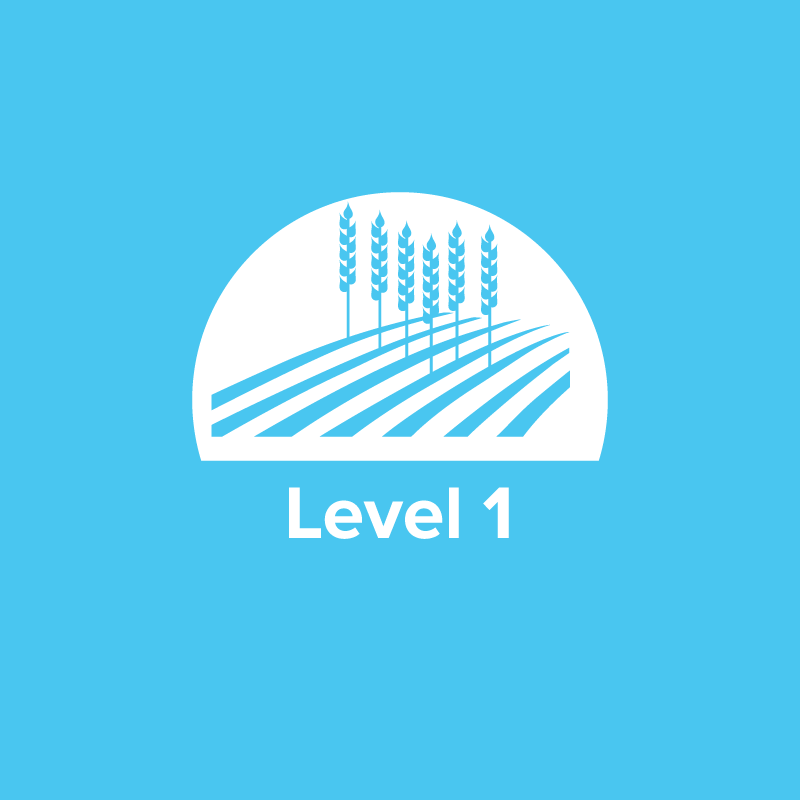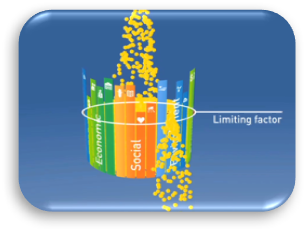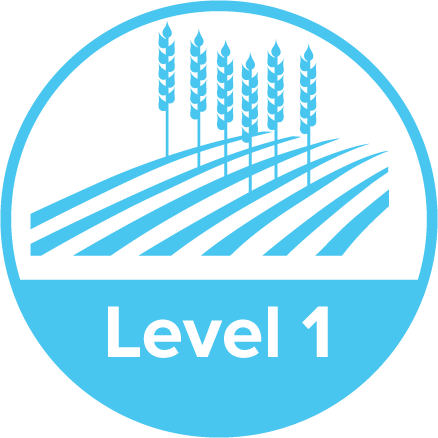Journey 2050 Lesson 1: Sustainable Agriculture (Grades 6-8)
Students will explore the core question, “How will we sustainably feed nearly 10 billion people by the year 2050?” as they discover what sustainable agriculture is and how it is critical to securing a stable food supply and future for a growing population.

Background
Lesson Activities
Recommended Companion Resources
Credits
Author
Lindsey Verhaeghe, Andrea Gardner, Debra Spielmaker, and Sara Hunt | National Center for Agricultural Literacy (NCAL) and Nutrien
Acknowledgements
The Journey 2050 program was originally developed by Nutrien in collaboration with Calgary Stampede, Alberta Canola Producers Commission, Nutrients for Life Foundation, and Agriculture in the Classroom Canada. Authors and contributors were drawn from each of these organizations under the direction of Lindsey Verhaeghe (Nutrien) and Robyn Kurbel (Calgary Stampede.) The lessons were updated and revised in 2017 and again in 2022 with contributions from the original J2050 Steering Committee, the National Center for Agricultural Literacy, and the National Agriculture in the Classroom Organization.
Sources
- http://www.economist.com/node/18200702
- Sustainable Development Network Solutions (2013). Solutions for Sustainable Agriculture and Food Systems http://unsdsn.org/mwg-internal/de5fs23hu73ds/progress?id=EHV3NQH3C4-PP-EivDwXY4i2HzIjIWty8lBnkNioco0,
- http://www.fao.org/mwg-internal/de5fs23hu73ds/progress?id=HXecPI0p3XpJtFbAsjLRZd3G4ZjPgUW5N3PqtZYwwio
- http://waterfortheworld.net/index.php?id=12
- http://www.un.org/sustainabledevelopment/sustainable-development-goals/
- Sustainable Development Network Solutions (2013). Solutions for Sustainable Agriculture and Food Systems http://unsdsn.org/mwg-internal/de5fs23hu73ds/progress?id=EHV3NQH3C4-PP-EivDwXY4i2HzIjIWty8lBnkNioco0,
- https://www.un.org/sustainabledevelopment/poverty/
- https://www.wfp.org/stories/5-facts-about-food-waste-and-hunger#:~:text=1, and http://www.un.org/waterforlifedecade/food_security.shtml
- https://irp-cdn.multiscreensite.com/be6d1d56/files/uploaded/TG07-Agriculture-Report-WEB.pdf
- http://www.economist.com/node/18200702
- http://www.worldfooddayusa.org/food_waste_the_facts
- http://www.un.org/en/globalissues/briefingpapers/population/vitalstats.shtml
- Sustainable Development Network Solutions (2013). Solutions for Sustainable Agriculture and Food Systems http://unsdsn.org/mwg-internal/de5fs23hu73ds/progress?id=EHV3NQH3C4-PP-EivDwXY4i2HzIjIWty8lBnkNioco0
Standards
Texas Content Area Standards
-
Principles of Agriculture, Food, and Natural Resources: 130.2.c.1
The student demonstrates professional standards/employability skills as required by business and industry. The student is expected to:
- Principles of Agriculture, Food, and Natural Resources: 130.2.c.1.B: apply competencies related to resources, information, interpersonal skills, problem solving, critical thinking, and systems of operation in agriculture, food, and natural resources.
-
Principles of Agriculture, Food, and Natural Resources: 130.2.c.4
The student explains the historical, current, and future significance of the agriculture, food, and natural resources industry. The student is expected to:
- Principles of Agriculture, Food, and Natural Resources: 130.2.c.4.B: analyze the scope of agriculture, food, and natural resources and its effect upon society.
- Principles of Agriculture, Food, and Natural Resources: 130.2.c.4.C: evaluate significant historical and current agriculture, food, and natural resources developments.
- Principles of Agriculture, Food, and Natural Resources: 130.2.c.4.E: describe how emerging technologies and globalization impacts agriculture, food, and natural resources.
- Principles of Agriculture, Food, and Natural Resources: 130.2.c.4.F: compare and contrast issues impacting agriculture, food, and natural resources such as biotechnology, employment, safety, environment, and animal welfare issues.
- Principles, of Agriculture, Food, and Natural Resources: 130.2.c.4.D: identify potential future scenarios for agriculture, food, and natural resources systems, including global impacts.
-
Principles of Agriculture, Food, and Natural Resources: 130.2.c.6
The student demonstrates appropriate personal and communication skills. The student is expected to:
- Principles of Agriculture, Food, and Natural Resources: 130.2.c.6.A: demonstrate written and oral communication skills appropriate for formal and informal situations such as prepared and extemporaneous presentations.
- Principles of Agriculture, Food, and Natural Resources: 130.2.c.6.B: demonstrate effective listening skills appropriate for formal and informal situations.
-
Social Studies: 6.113.18.c.14
Culture. The student understands that all societies have basic institutions in common even though the characteristics of these institutions may differ. The student is expected to:
- Social Studies: 6.113.18.c.14.C: analyze the efforts and activities institutions use to sustain themselves over time
-
Science: 6.112.26.b.1
Scientific and engineering practices. The student, for at least 40% of instructional time, asks questions, identifies problems, and plans and safely conducts classroom, laboratory, and field investigations to answer questions, explain phenomena, or design solutions using appropriate tools and models. The student is expected to:
- Science: 6.112.26.b.1.A: ask questions and define problems based on observations or information from text, phenomena, models, or investigations
-
Science: 6.112.26.b.3
Scientific and engineering practices. The student develops evidence-based explanations and communicates findings, conclusions, and proposed solutions. The student is expected to:
- Science: 6.112.26.b.3.A: develop explanations and propose solutions supported by data and models and consistent with scientific ideas, principles, and theories;
-
Science: 6.112.26.b.5
Recurring themes and concepts. The student understands that recurring themes and concepts provide a framework for making connections across disciplines. The student is expected to:
- Science: 6.112.26.b.5.A: identify and apply patterns to understand and connect scientific phenomena or to design solutions;
-
Science: 6.112.26.b.11
Earth and space. The student understands how resources are managed. The student is expected to:
- Science: 6.112.26.b.11.A: research and describe why resource management is important in reducing global energy poverty, malnutrition, and air and water pollution; and
-
Science: 7.112.27.b.1
Scientific and engineering practices. The student, for at least 40% of instructional time, asks questions, identifies problems, and plans and safely conducts classroom, laboratory, and field investigations to answer questions, explain phenomena, or design solutions using appropriate tools and models. The student is expected to:
- Science: 7.112.27.b.1.A: ask questions and define problems based on observations or information from text, phenomena, models, or investigations;
-
Science: 7.112.27.b.3
Scientific and engineering practices. The student develops evidence-based explanations and communicates findings, conclusions, and proposed solutions. The student is expected to:
- Science: 7.112.27.b.3.A: develop explanations and propose solutions supported by data and models and consistent with scientific ideas, principles, and theories;
-
Science: 7.112.27.b.5
Recurring themes and concepts. The student understands that recurring themes and concepts provide a framework for making connections across disciplines. The student is expected to:
- Science: 7.112.27.b.5.A: identify and apply patterns to understand and connect scientific phenomena or to design solutions;
-
Science: 8.112.28.b.1
Scientific and engineering practices. The student, for at least 40% of instructional time, asks questions, identifies problems, and plans and safely conducts classroom, laboratory, and field investigations to answer questions, explain phenomena, or design solutions using appropriate tools and models. The student is expected to:
- Science: 8.112.28.b.1.A: ask questions and define problems based on observations or information from text, phenomena, models, or investigations;
-
Science: 8.112.28.b.3
Scientific and engineering practices. The student develops evidence-based explanations and communicates findings, conclusions, and proposed solutions. The student is expected to:
- Science: 8.112.28.b.3.A: develop explanations and propose solutions supported by data and models and consistent with scientific ideas, principles, and theories;
-
Science: 8.112.28.b.5
Recurring themes and concepts. The student understands that recurring themes and concepts provide a framework for making connections across disciplines. The student is expected to:
- Science: 8.112.28.b.5.A: identify and apply patterns to understand and connect scientific phenomena or to design solutions;
-
Science: 8.112.28.b.12
Organisms and environments. The student understands stability and change in populations and ecosystems. The student is expected to:
- Science: 8.112.28.b.12.A: explain how disruptions such as population changes, natural disasters, and human intervention impact the transfer of energy in food webs in ecosystems;
- Science: 8.112.28.b.12.B: describe how primary and secondary ecological succession affect populations and species diversity after ecosystems are disrupted by natural events or human activity; and
- Science: 8.112.28.b.12.C: describe how biodiversity contributes to the stability and sustainability of an ecosystem and the health of the organisms within the ecosystem.
-
Science: 7.112.27.b.11
Earth and space. The student understands how human activity can impact the hydrosphere. The student is expected to:
- Science: 7.112.27.b.11.A: analyze the beneficial and harmful influences of human activity on groundwater and surface water in a watershed; and
-
Technology Applications: 126.17.c.1
Computational thinking--foundations. The student explores the core concepts of computational thinking, a set of problem-solving processes that involve decomposition, pattern recognition, abstraction, and algorithms. The student is expected to:
- Technology Applications: 126.17.c.1.A: decompose real-world problems into structured parts by using visual representation
- Technology Applications: 126.17.c.1.B: analyze the patterns and sequences found in visual representations such as learning maps, concept maps, or other representations of data
- Technology Applications: 126.17.c.1.D: design a plan collaboratively using visual representation to document a problem, possible solutions, and an expected timeline for the development of a coded solution
-
Technology Applications: 126.18.c.1
Computational thinking--foundations. The student explores the core concepts of computational thinking, a set of problem-solving processes that involve decomposition, pattern recognition, abstraction, and algorithms. The student is expected to:
- Technology Applications: 126.18.c.1.A: decompose real-world problems into structured parts using flowcharts
- Technology Applications: 126.18.c.1.B: analyze the patterns and sequences found in flowcharts
 The economic component of sustainability is about earning money—creating jobs and incomes to support the national and local community. The social element encompasses things like food, education, medical care and infrastructure, including the roads used to transport food from the farm to your plate. And finally, there are environmental needs to consider. Soil quality needs to be maintained, habitats need protection, water must be conserved, and we need to protect our atmosphere by keeping greenhouse gas emissions to a minimum.
The economic component of sustainability is about earning money—creating jobs and incomes to support the national and local community. The social element encompasses things like food, education, medical care and infrastructure, including the roads used to transport food from the farm to your plate. And finally, there are environmental needs to consider. Soil quality needs to be maintained, habitats need protection, water must be conserved, and we need to protect our atmosphere by keeping greenhouse gas emissions to a minimum.